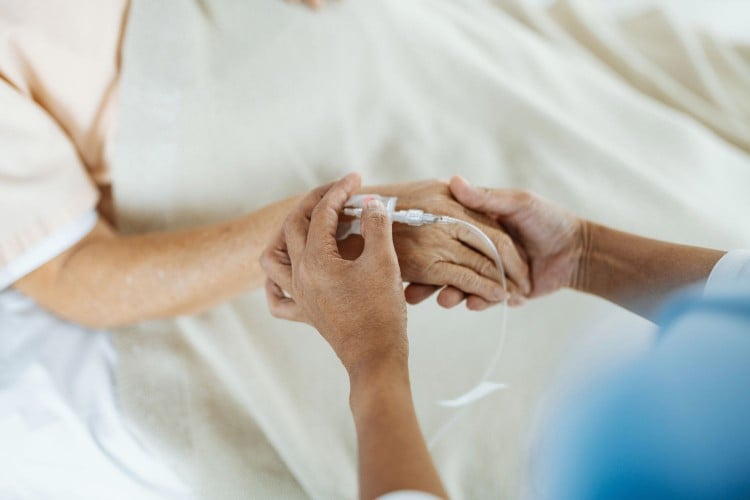- Michael Strahan’s daughter Isabella revealed Thursday that she was diagnosed with and is being treated for medulloblastoma, a rare cancerous brain tumor.
- There are fewer than 500 medulloblastoma cases diagnosed each year, and the large majority are in children.
- Medulloblastoma can be treated, and symptoms such as balance issues, headaches, nausea, or limb weakness are signs that someone should seek medical attention.
Isabella Strahan, daughter of TV host and former NFL star Michael Strahan, is currently undergoing treatment after being diagnosed with medulloblastoma, a rare malignant brain tumor.
Isabella, 19, shared the news Thursday in an interview with her father and his Good Morning America co-anchor Robin Roberts. During the interview, Isabella explained that she was diagnosed with the brain tumor in late October, just weeks after her symptoms appeared.
“I didn’t notice anything was off [until] probably like October 1,” she said. “That’s when I definitely noticed headaches, nausea, couldn’t walk straight.” By October 25, Isabella said she was “throwing up blood,” so her family urged her to seek immediate medical attention.
After a thorough check-up and MRI, doctors discovered a “fast-growing, 4-centimeter tumor” in the back of her brain that was larger than a golf ball. Isabella quickly underwent surgery to remove the tumor, followed by rehabilitation and six weeks of radiation.
With surgery and radiation therapy behind her, Isabella said she’s starting chemotherapy at Duke Children’s Hospital & Health Center in early February. She’ll be documenting her experience on her YouTube channel, which will support Duke’s cancer center. Isabella added that she’s feeling good and “very excited for this whole process to wrap.”
“But it’s still scary because it’s still so much to go through,” Michael told Good Morning America. “And the hardest thing to get over is to think that she has to go through this herself.”
Here’s what to know about medulloblastoma, treatment processes for the tumor, and important risk factors and warning signs to recognize.
:max_bytes(150000):strip_icc()/Health-GettyImages-1161451946-6f3d83b8089547cba526b2567a9e32e2.jpg)
Neilson Barnard/Getty Images
What Is Medulloblastoma?
Medulloblastoma is a central nervous system tumor, which means that it’s found in the brain or the spinal cord. These tumors often appear in the cerebellum—the part of the brain located in the back of the head—and usually form in fetal cells that remain in the brain after a person is born.
One of the major concerns with medulloblastoma is that the tumor can grow and spread very quickly. Though usually formed in the brain, the cancer can spread throughout the central nervous system, in particular the spinal cord.
Based on where the medulloblastoma is, how much it’s spread, and other factors, patients are split into four subtypes: WNT-activated, SHH-activated, Group 3, or Group 4.
These classifications work well for pediatric cases, but adult cases are not as “well-defined,” according to the National Cancer Institute. In spite of these limitations, the SHH-activated subtype seems to be the most common in adults, making up about 60% of medulloblastoma cases.
In general, medulloblastoma cases in adults aren’t as well-understood as they are in children. Adult cases only make up between 14% and 30% of all medulloblastomas, and adults that develop the tumor tend to be younger themselves, between 20 and 40 years old.
It’s a rare tumor—estimated to account for fewer than 500 cases annually. Still, medulloblastomas account for 20% of all pediatric brain tumors, making them the most common type of malignant brain tumor in kids.
In contrast, medulloblastomas make up between 0.4% and 1% of all central nervous system tumors in adults.
This Person's Brain Tumor Symptoms Were Dismissed as Benign Headaches
Recognizing Symptoms and Seeking Treatment
Like any cancer, there’s not a clearly defined mechanism for how to avoid medulloblastoma.
According to the National Cancer Institute, likely some percentage of medulloblastomas in kids are related to genetic mutations. Inherited diseases Li-Fraumeni syndrome, nevoid basal cell carcinoma syndrome, and Turcot syndrome have been linked to the development of medulloblastomas.
For adults, there’s no known cause. And in general, there are no obvious risk factors or actions people could take to ensure they or their children don’t develop medulloblastoma.
However, people can educate themselves on the symptoms or warning signs that a tumor has developed. Those symptoms depend on the tumor’s location.
If a person has a medulloblastoma on their cerebellum or the back of the brain, they may experience balance problems or other fine motor problems.
In situations where the tumor is interfering with the cerebral spinal fluid (CSF), people may have more pressure in their heads, known as hydrocephalus. This can lead to nausea, vomiting, headaches, confusion, or blurred vision.
Finally, if the medulloblastoma has reached the spine, people may feel weakness in their limbs or spinal pain.
As was the case with Isabella, it’s important that people seek medical attention if they’re experiencing any of these symptoms. Medulloblastomas can be treated, and when they’re treated early, they tend to have a good prognosis—the 5-year survival rate for people with the tumor is about 72%.
Though the cancer grows fast, in most cases medulloblastomas don’t spread outside the central nervous system. If possible, doctors will remove the tumor via surgery, and then depending on the patient, may recommend radiation or chemotherapy.
However, treatment can be a bit more complicated for adults—since there are so few cases, trials on medulloblastoma treatment tend to be done in children. So treatments shown to be effective on kids are usually replicated on adults, though this isn’t ideal due to molecular and toxicity differences, a group of researchers said in a 2022 article. More research is needed to ensure all people with medulloblastoma are receiving ideal care.
As for Isabella, she hopes that her story can provide hope for people potentially going through similar situations.
“I hope to just kind of be a voice,” she said in her Good Morning America interview, “[someone] who people, maybe [those who] are going through chemotherapy or radiation can look at.”
Signs and Symptoms of a Brain Tumor








